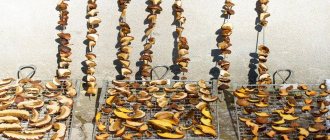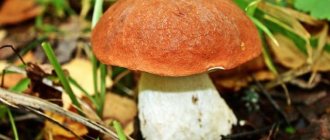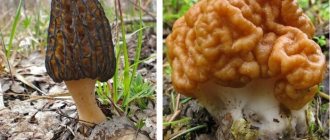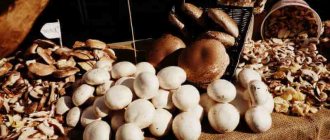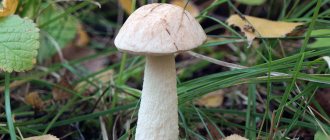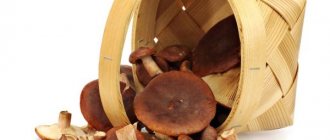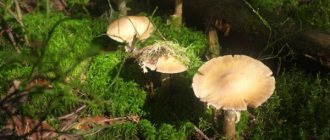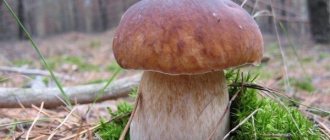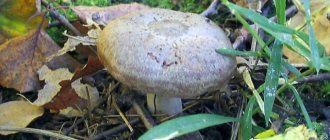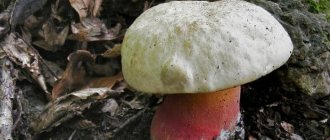Mushrooms
0
1742
Article rating
Kira Stoletova
Many beneficial mushrooms have a poisonous or inedible counterpart. False oiler is one such type. Any mushroom picker, even a beginner, needs to be able to distinguish a double from a real mushroom, especially since false boletus is common in local forests.
Description of the false oiler
Do false boletus exist in nature?
False Butter is not a false treat at all
. In fact, the term “false butter” is not entirely correct. There are no species of mushrooms with this name - by this name they usually mean a collection of several types of mushrooms that are similar to ordinary, common, well-edible and well-known boletus, but do not have their taste benefits.
That is, “false boletus” does not mean “dangerous, poisonous or harmful,” as is the case with some other genera of mushrooms. This means, simply, NOT AS TASTY AS NORMAL BUTTER.
False boletus is not a false treat at all.
Among the species that are traditionally called false boletus, there are no poisonous or inedible ones. They are, as a rule, classified as edible, or conditionally edible, and, when cooked, look very decent. You cannot be poisoned by them; moreover, many collectors love these mushrooms very much and eat them with great pleasure.
Below is a description of several types of mushrooms, often classified as false boletus.
Butter, how to cook. How to cook boletus
Among the gifts of the forest, boletus is especially popular because it has excellent taste and can be used as an element in various mushroom dishes. But in order for the prepared dish to have all the necessary taste qualities, the butter must be prepared correctly.
Before you start cooking, you need to prepare the butter:
- arrange the mushrooms on a wire rack or baking sheet for greater convenience;
- dry them for about 30 minutes;
- clean the caps from dirt and debris, if desired, remove the film from the stem;
- Place the processed mushrooms in a pan filled with water.
Before continuing cooking, strain the water in which the boletus was stored - this will improve their taste after cooking.
Pepper Butterfly Chalciporus piperatus
False Butterflies are not a false treat at all.
A mushroom from the genus Halciporus, family Boletaceae, also known as Pepper Boletus.
This mushroom is very similar to the usual types of boletus, but differs from them in its more pungent peppery taste, for which it is often characterized as conditionally - edible, or even inedible - to the great surprise of mushroom pickers who collect and, with pleasure, eat it for many years.
Appearance
The cap is up to 6 cm in diameter, rounded and convex, with a dry, slightly velvety surface, painted in copper-red or dark rusty tones.
The hymenophore is tubular, the tubes descend along the stalk, are colored the same tone as the cap, or a little darker, the pores are uneven and wide. When pressed, the tubes change color to dirty brown. Spore powder is yellow-brown.
The leg is up to 8 cm long and up to 1.5 cm thick, has a cylindrical shape, can be curved and slightly narrowed downward. Colored in the same shade as the cap, more yellowish in the lower part. It does not have a ring, which makes it very different from most ordinary butter.
The pulp is sulfur-yellow, reddening when cut, with a faint odor and a sharp peppery taste.
Where and when does it grow
Grows in dry coniferous forests, from July to November. It can sometimes form mycorrhiza with young birch and other deciduous trees. It is often found in habitats, but not abundantly, so you still need to try to collect a whole basket of “pepper peppers”.
Similarity to boletus
Despite all the general similarities, it is not at all difficult to distinguish the peppercorn from ordinary butterweed - by the absence of a ring on the stem, the reddish tint of the spore-bearing layer, and, of course, the pungent taste, which is easy to feel by slightly biting the flesh.
The question of edibility
Despite numerous indications from various sources that “the mushroom is inedible due to its too pungent taste,” a huge number of people calmly collect and eat peppercorns, without even knowing about such horror stories.
According to reviews from experienced foragers, a frying pan of freshly fried peppercorns is indeed a spicy dish, and not for everyone, but certainly not inedible. Apparently, the pulp of this mushroom has the most pungent taste in its raw form. After heat treatment, the degree of pungency drops sharply and does not pose any threat to the taste, and if peppercorns are mixed with other mushrooms, the pungency is not felt at all. Connoisseurs note the excellent taste of this mushroom and complain that it is not so easy to collect it in our forests in sufficient quantities.
So, those who want to try Pepper Butter can be recommended to soak it in water for 2 hours before using it, or boil it for 15 minutes before further culinary use. And lovers of spicy dishes can safely fry the peppercorns raw.
Places of growth
The oiler is ordinary - traditional for Russian areas. It is found more often in deciduous forests and pine forests, and also in plantings among heather and cereals.
Boletus also grows in Africa and Australia (wherever the climate is close to temperate). False mushrooms accompany their edible counterparts everywhere.
Usually boletus grows well on sandy or calcareous soils, in small families, so collecting them is very convenient - a pleasure.
Grows well in well-drained sandy soils. They do not like particularly strong shading, and therefore are slightly less common in heavily overgrown forests. There is a high probability of finding them in thinned out pine plantings, on pine forest edges, along the edges of forest roads on the side of the road, and even on old fire pits.
Boletus can perfectly coexist with chanterelles, porcini mushrooms and russula.
Goat Suillus Bovinus
False Buttercups are not a false treat at all.
A mushroom from the genus Butterdish, the Buttercup family, is also known as Dry Butterdish and Goat Mushroom.
Goat is also quite edible after a short preliminary boiling.
Appearance
The cap is up to 12 cm in diameter, initially convex, then cushion-shaped, flat-convex and flat in shape. Its color varies from reddish-brown to red-brown and red-ocher. The cap is bare, smooth and slightly sticky to the touch, slimy in wet weather. Unlike ordinary butter, it is difficult to remove it from the cap - it comes off only in small shreds.
The hymenophore is tubular, weakly descending onto the stalk, the pores are large, with torn angular edges. Their color varies from yellowish and brownish-yellowish to reddish-olive and brownish-yellow. Spore powder is yellow-olive or light brown in color.
The leg is up to 10 cm high and up to 2 cm thick, cylindrical, smooth and dense, sometimes curved and narrowed downwards. It is painted the same color as the cap, or a little lighter, yellowish at the base.
The pulp is elastic and dense, becomes more rubbery as the fruit body ages, has a light yellow tint in the cap, and yellowish-brownish in the stem. The pulp may turn pink when cut, and after heat treatment it becomes pinkish-purple. It has a faint mushroom smell and a slightly sour taste.
Where and when does it grow
This fungus forms mycorrhiza with pine and loves acidic, nutritious soils, in moist places near swamps, or along roadsides. Often found in artificial plantings of young pines. It bears fruit in August–September both in large groups and individually. Widely distributed throughout the northern temperate zone - the European part of Russia, the Far East, the North Caucasus, Siberia and the Urals. After heavy rains, this mushroom appears in large groups, which cannot but please lucky mushroom pickers.
Great friend of worms
The famous feature of Kozlyak, noted by many experts, is that it is VERY wormy. A situation where there are several dozen goats in a clearing, but in the end, none of them is suitable for use, since they are all completely eaten away, is a common occurrence. Therefore, when collecting these mushrooms, it is strongly advised not only to cut off the stems, but also to cut the caps - it happens that the outside is intact, but the inside is corroded from edge to edge.
Similarity to boletus
Kozlyak, in general, is the same butterdish, from the same genus and family, therefore it is quite similar to other butterdish. It is easily distinguished by its less sticky skin and the fact that it is difficult to remove from the cap.
The question of edibility
Kozlyak is a very good edible mushroom. It is wonderful both fried and stewed, very good in marinade, and is highly appreciated by lovers of mushroom cuisine. When cooked, the goat turns pink, but there is nothing scary about it.
It is officially recommended that this mushroom be boiled for 20 minutes before cooking, but most foragers never do this.
What are the similarities between edible and inedible boletus mushrooms?
Comparing photos of edible and inedible boletus, it is easy to see how they are similar. Most of them have convex caps covered with slippery slimy skin (the exception is the “false” yellow-brown appearance), colored primarily in various shades of brown and red. The legs are usually cylindrical in shape and have a smooth or fibrous surface. They come in medium thickness and completely different heights (from 3 to 12 cm), depending on the size of the mushroom. Compared to the caps, they are lighter in color. Some species have a ring on the stalk, while others do not.
Conventionally called “false” boletus mushrooms, which actually belong to the genus of the same name in the Maslenkov family of the Boletaceae order, are tubular mushrooms. The exception is spruce weevil. This “false oiler” is actually not such a thing. He is a representative of the Mokrukhov family of the Boletov order; it is a lamellar mushroom.
The video will tell you more about the spruce weevil, where it grows and what these so-called “false boletus” are.
True and “false” species are related by their habitats - pine plantings, as well as mixed forests, where, in addition to coniferous trees, a large number of oaks and birches grow. They love clearings illuminated by the sun, grow well on forest edges and along roads, and often hide under fallen pine needles. They are found almost everywhere in the cool temperate climate of central and northern Russia.
Both real and “false” boletus most often grow in groups, although single specimens may also occur. They appear in abundance two to three days after the rain. These mushrooms also love generous morning dew.
In general, the boletus season falls from June to October, but the peak of the simultaneous appearance of various species occurs in August-September.
Siberian oiler Suillus Sibiricus
False Buttercups are not a false treat at all.
A mushroom from the genus Buttercup, the Buttercup family, quite edible, just belonging to the 2nd food category.
Appearance
The cap is up to 10 cm in diameter, mucous, broadly conical in young specimens, and cushion-shaped, with a tubercle, in mature specimens. The hat is colored in olive-yellow shades, with pronounced brown radial fibers.
The hymenophore is tubular, strongly descending onto the stalk, the tubes are yellow, narrower at the edges of the cap. Spore powder is light brown.
The leg is up to 8 cm long and up to 1.5 cm thick, cylindrical, often slightly curved. It is colored in sulfur-yellow shades and covered with brown spots - warts. The bottom of the leg is braided with light mycelial strands.
The pulp is yellow, does not change color when cut, without pronounced color or odor.
Where and when does it grow
It bears fruit from August to September in coniferous and coniferous-deciduous forests. Widely distributed in Siberia, the Far East, and the Altai Territory. Found in very large groups.
The Edibility Question
Good edible appearance, suitable for any type of cooking. Like all butters, before culinary use you need to remove the sticky skin from the cap so that the dish does not become bitter in the future.
Growth periods are difficult
What are the benefits of boletus? The harvest can be harvested starting in June, and the ripening of these mushrooms lasts until the first frost. And the false butterfly mushroom, accordingly, grows along with them.
It should be noted that it is best to collect mushrooms whose caps are no more than 4 centimeters in diameter, since non-overgrown specimens are much tastier. They appear several times in the summer, periodically.
Many may not know, but there is a first wave that occurs at the time when the rye begins to ear. At this time, the so-called spike mushrooms appear: porcini mushrooms and boletus mushrooms. They suddenly appear and then disappear.
Oiler Sour Suillus Acidus
False Butterflies are not a false treat at all.
A mushroom from the genus Butterfly, of the Buttercup family, is edible, but has a distinctly sour taste, which is why it is not very suitable for food.
Appearance
The cap is smooth, up to 10 and sometimes 17 cm in diameter, changing shape as it grows from convex to prostrate. The color of the cap varies from pale yellow in youth to light brown in mature specimens. Its surface is covered with an abundant layer of mucus, often forming darker clots when it dries. Along the edges of the cap, the remains of the coverlet often freeze in the form of small yellowish flakes.
Hymenophore tubular. The tubes are slightly descending to the stem, pale yellow in color, gradually darkening with age. In young fruiting bodies, drops of clear liquid are often released from them. Brown sor powder.
The leg is hard and solid, up to 12 cm long and up to 1.5 cm in diameter, high, cylindrical, or slightly club-shaped, has a pale yellow color with characteristic brownish spots. In young specimens, the stalk is often covered with liquid flowing from the hymenophore. There is a gelatinous felt ring on the stem, which often disappears with age.
The pulp is dense, pale ocher in color, does not change color when cut. It has a faint odor and a sour taste, especially in the skin on the cap.
Where and when does it grow
Sour butterwort bears fruit from July to October in the pine forests of Western Siberia. Prefers the company of cedar pine.
The question of edibility
The mushroom is quite edible, but is rarely collected by mushroom pickers because of its sour taste, although the main “sourness” is contained in the skin on the cap, and it still needs to be removed from butter mushrooms. According to experts, the taste of the mushroom is, of course, peculiar, but not at all unpleasant. As a rule, the youngest specimens of sour butterfish are used for pickling, after thorough cleaning and preliminary boiling.
Differences between false brothers
Unfortunately, most often mushrooms similar to boletus grow next to edible representatives of the tubular genus. Why do novice mushroom pickers often confuse false butterflies with their edible relatives? Although false representatives are most often not poisonous, they have an unpleasant bitter taste and can cause stomach upset. These include: Siberian butterfly, remarkable and pepper. The distinctive features of the false buttercup are that the color of the mushroom changes at the break, the cap is darker, and the spongy layer is red.
Spruce wetter Gomphidius glutinosus
False Boletus is not a false treat at all.
A mushroom from the genus Mokrukha, the Mokrukhov family, slightly similar to boletus in appearance and with a characteristic slimy cap. You can instantly distinguish this mushroom from boletus mushrooms by their lamellar hymenophore.
Appearance
The cap is up to 13 cm in diameter, hemispherical, with a rolled edge, in young specimens, later convex - conical and spread out, or slightly depressed in the center, with a small tubercle, in mature mushrooms. The cap is painted in grayish-blue tones, with a purple tint along the edge and a lighter middle; in mature specimens, the surface of the cap is covered with black specks, and white flakes from the remains of the bedspread remain along the edges. The skin is smooth, abundantly covered with mucus, after which it dries, it becomes shiny.
The hymenophore is lamellar, the plates are sparse, descending, highly branched and thick, changing color as they grow older, from light gray to purple-brown. In very young mushrooms they are covered with a filmy cover. Spore powder is dark brown.
The leg is up to 11 cm high and up to 2.5 cm in diameter, massive, smooth and high, cylindrical or slightly club-shaped. Grayish-white at the top and lemon-yellow at the base, and covered with darkish scales on top. The leg is heavily covered with mucus and has a faint filmy ring, which often disappears with age.
The pulp is light, fleshy and fragile, and may have a pinkish, grayish or yellowish tint. It has a faint mushroom smell and a slightly sweet or sour taste.
Where and when does it grow
It grows from mid-July to the end of October, in coniferous, especially spruce, forests, in moss and forest litter, among heather, usually in large groups. Widely distributed in central and northern Russia. It bears fruit en masse from the second half of August until the end of September.
The question of edibility
Mokrukha is a completely edible mushroom, but it requires removing the mucous skin from the cap and clearing the mucus from the stem. After this, the fruiting bodies are boiled for 15 minutes, after which it can be pickled or salted, and also used to prepare sauces or a side dish for meat dishes.
So, the false butter dish is not a dangerous mushroom at all, but, on the contrary, has its own merits and has its many fans. Let these mushrooms continue, despite their suspicious name, not to be deprived of the attention of connoisseurs and experts in quiet hunting.
Inedible and poisonous counterparts
It’s one thing to confuse butter mushrooms with edible analogues that will not harm the body, but what can you do to avoid bringing poisonous mushrooms into your home?
False boletus
Before plucking another forest dweller, you need to carefully examine it. If the latter is far from the present, then its inner surface will have pronounced plates. Also, in poisonous individuals, the cap has a purple tint.
To finally make sure it is edible, you need to inspect the inside. Peel off the light film and evaluate the structure of the cap. If it is porous, then feel free to put the mushroom in the basket; if it is lamellar, throw it away. In addition, the leg is of no small importance. If it is purple and turns yellow when cut, then it is a “false” representative.
Remember!
Also, toxic individuals are more porous and crumble heavily.
Panther fly agaric
You may be interested in: How do edible talkers differ from false mushrooms? How many days after rain do mushrooms grow? Bitter mushroom: photo and detailed description
Panther fly agarics prefer areas with temperate climatic conditions. They often form a mycelium with most coniferous and deciduous trees. You can stumble upon them in July-October.
The cap is rounded-convex, later half-spread with a small depression in the middle. Its color varies from light to dark brown. The color is darker at the center and lighter at the periphery. At the apex there are numerous white warts, which are located concentrically.
Striped striations are visible along the edge. In rain the surface is slimy, and in dry weather it is dry and shiny. Under the cap there are many plates, expanding towards the periphery. The pulp is tasteless with an unpleasant aroma. The stalk is tuberous-swollen at the base. There are warts on it. There is also a striped white ring present that disappears over time.
Now, having detailed knowledge in differentiating boletus, you can safely go to harvest. We must not forget that determining whether they belong to a particular family is not enough; you need to know how to properly process and prepare them.
Is it possible to grow at home, methods of reproduction?
Mycology develops every year, offering mushroom pickers the cultivation of wild mushrooms in their garden plots. By sowing mushroom spores of false boletus and transferring the mycelium with his own hands in the forest, the gardener will be able to harvest the crop in a year at his dacha, subject to following the recommendations and advice.
Having studied the false butterdish in detail with a photo and description of the mushroom, every novice mushroom picker will be able to go on a quiet hunt without fear for their health and the condition of their family and friends. The most important thing is not to forget to get ready by putting in your backpack: a compass or navigator, a knife for cutting the stem, gloves so as not to wash your hands for a week and a clear example of what a real butter dish and its edible and semi-edible analogues look like.
Characteristic features of the species and rules for collecting boletus
In order to know what boletus looks like, you need to familiarize yourself with the features of the species and photos. The mushroom cap varies in structure and can be wavy or smooth, in the shape of a cone or hemisphere, which with age becomes more reminiscent of a pad. It can be brown or chocolate, depending on the light. Dimensions can reach 15 cm in diameter.
The hat is also covered with a special mucus that protects the mushroom from damage and bacteria. The presence of mucus clearly distinguishes oilers from other families. The spore-bearing layer is easily separated from the cap. The leg is full, smooth, granular. Sometimes you can find sections of the bedspread in the form of a ring. The pulp is white, with a yellowish tint; if the stem is cut, the color changes to red or blue. The spores are yellow.
Most often, boletus is distributed in the Northern Hemisphere, but in exceptional cases they can be found in Australia and African countries. Some species grow with only one type of tree, while others can live with various conifers - pine, larch, etc., but will feel comfortable only in well-lit forests. They can often be found in forest belts, coniferous thickets and forest clearings.
Mushrooms bear fruit from the beginning of summer until the end of autumn. The most optimal temperature for butter is +150C. The appearance can be expected immediately after rain. They do not like the cold very much and stop growing when the soil freezes to 3 cm. You need to collect oils very carefully so as not to damage the mycelium. Mushroom pickers use a special mushroom knife to cut off the stem as close to the ground as possible and immediately clean the mushroom of soil and debris.
Mushrooms that look like boletus turn blue when cut when peeled, why, photo
Why boletus and similar mushrooms turn blue when cut when peeled: reasons
Mushroom poisoning is a rather annoying phenomenon, and in most cases it is fatally unsafe. This is actually why many, even qualified mushroom pickers, are suspicious of any original phenomena that are associated with their collection. One of these phenomena is the bluing of the site of damage or fracture of the fruiting bodies. Very often, boletus-like mushrooms turn blue when cut. Next we will consider whether this is considered the norm and whether it poses a danger to the mushroom picker.
Do boletus turn blue when cut?
The question of whether oilcans can turn blue in places of damage worries many mushroom pickers. But, in general, a change in the color of the fruiting body when damaged is inherent in virtually all representatives of the mushroom kingdom, without exception. It’s just that in many species it is virtually invisible, in others the color may be slightly different, and in others (especially representatives of the Boletaceae family) it can occur very strongly.
Below is a photo illustrating this phenomenon:
Why do boletus turn blue when cut?
The basis for the change in color of the stem or cap when damaged (it does not matter whether it is a cut or the result of cleaning) is considered to be an oxidative chemical. the reaction of the juices of the fruiting body and the oxygen contained in the air.
The cut breaks the tightness of the stem, and the juices react with atmospheric oxygen. This property is characteristic of all mushrooms without exception.
What varieties of butternut squash turn blue when cut?
There are several types of Maslenkov, the place of damage of which turns blue:
- Larch gray or bluish. Its characteristic feature is its almost flat cap. Its surface is light brown. The stem should turn blue after cutting, which is reflected in its name. Still, it belongs to edible (albeit category 3), it is often eaten in salted form.
- Yellow-brown. His hat is the right color. It is classified as inedible, although not toxic.
- Peppery. It differs from ordinary representatives of Boletaceae by the absence of a ring and a reddish hymenophore. Also conditionally edible, but non-poisonous. Due to its immensely pungent taste, it is used infrequently as an additive, similar in effect to spices.
What other mushroom that looks like an oil can turns blue when cut?
Not only mushrooms such as boletus turn blue when cut. There are several types that also have a similar property:
- The bruise is normal. Belongs to the genus Giroporus of the Boletaceae family. It has a large cap with a diameter of more than 15 cm. The stem is white, the cap is beige.
- Moss fly is yellow-brown. Conditionally edible, similar in appearance to the Maslenkovs. If the color change occurred almost immediately after the break, it is most likely a flywheel. A characteristic feature is that the cap is quite thick. Moreover, when cooked, this species turns all its “neighbors” red.
- Dubovik. A large olive-brown representative of the boletus genus. Found mainly in oak groves.
- Polish mushroom. Also a representative of boletus. Quite large, has a large and fleshy hemispherical cap. It is very tasty, almost a gourmet dish. It is found in both coniferous and deciduous forests.
- Ryzhik. Also refers to the “blue” ones, but there is no doubt about its edibility.
- Hell's mushroom. It has a squat and thick body with a red leg and a white cap. It changes color at the site of damage, but it is difficult to confuse it with any edible representative due to its distinctive appearance.
As can be seen from the description, a change in color at the site of damage is characteristic of a fairly large number of very different species, and there is nothing dangerous in this phenomenon.
Should I worry if the butterfly mushroom turns blue when cut?
If boreal oils turn blue, there is no danger in this. This property is distinctive not only for representatives of this genus, but also for many others, having the most diverse origins and growth conditions.
Conclusion
The phenomenon when butter mushrooms turn blue when cut is considered normal and real. This is an ordinary reaction of the mutual action of mushroom juice and oxygen. This phenomenon cannot be attributed to a sign of toxicity, because it is inherent in representatives of all kinds of genera of the mushroom kingdom. If the oiler changes color during collection or cleaning, there is no need to throw it away and wash the instrument. If a given specimen has been definitely identified as edible, it can safely be eaten.
Use
It is believed that yellow-brown butterdish is most suitable for pickling. At the same time, it is important not to pack the mushrooms into the jar too tightly - the butter mushrooms tend to stick to each other.
You can fry yellow-brown butterdish, it turns out delicious, but some people note heaviness in the stomach after eating. So, if you fry it, it’s better to first do it in small quantities - to test. Fry without pre-boiling! Yellow-brown boletus is good when stewed in the company of other boletus or with cabbage.
In dried form, boletus is used in mushroom soups to add a special taste and aroma. It is preferable to dry only caps that are small in size and not wormy.
A characteristic feature of the yellow-brown butterdish is the pine aroma of the pulp. Some people like it, others, on the contrary, do not collect it and do not use it for food precisely because of this. It is also worth noting that very large specimens of the yellow-brown oiler are often wormy, so it is better not to take them.
Why boletus and similar mushrooms turn blue when cut when peeling: reasons
Mushroom poisoning is a rather unpleasant phenomenon, in some cases deadly. That is why many, even experienced mushroom pickers, are suspicious of any non-standard phenomena associated with their collection. One of these phenomena is the bluing of the site of damage or fracture of the fruiting bodies. Quite often, mushrooms that look like boletus turn blue when cut. Next we will consider whether this is the norm and whether it poses a danger to the mushroom picker.
Do boletus turn blue when cut?
The question of whether oilcans can turn blue in places of damage worries many mushroom pickers. But, in general, a change in the color of the fruiting body when damaged is characteristic of almost all representatives of the mushroom kingdom, without exception. It’s just that in some species it is almost invisible, in others the color may be slightly different, and in others (in particular, representatives of the Boletaceae family) it can be especially pronounced.
Below is a photo illustrating this phenomenon:
Why do boletus turn blue when cut?
The reason for the change in color of the stem or cap when damaged (no matter whether it is a cut or the result of cleaning) is the oxidative chemical reaction of the juices of the fruiting body and the oxygen contained in the air.
The cut breaks the tightness of the stem, and the juices react with atmospheric oxygen. This property is inherent in all mushrooms without exception.
What types of oilseeds turn blue when cut?
There are several types of Maslenkov, the place of damage of which turns blue:
- Larch gray or bluish. Its distinctive feature is its almost flat cap. Its surface is light brown. The stem should turn blue after cutting, which is reflected in its name. Nevertheless, it is classified as edible (albeit category 3); it is often eaten salted.
- Yellow-brown. His hat is the same color. It is classified as inedible, although not poisonous.
- Peppery. It differs from ordinary representatives of Boletidae in the absence of a ring and a reddish hymenophore. Also conditionally edible, but non-poisonous. Due to its excessively pungent taste, it is rarely used as an additive similar in effect to spices.
What other mushroom that looks like an oil can turns blue when cut?
Not only mushrooms such as boletus turn blue when cut. There are several types that also have a similar property:
- An ordinary bruise. Belongs to the genus Giroporus of the Boletaceae family. It has a large cap with a diameter of more than 15 cm. The stem is white, the cap is beige.
- Moss fly yellow-brown. Conditionally edible, similar in appearance to the Maslenkovs. If the color change occurs almost immediately after the break, it is most likely a flywheel. A distinctive feature is that the cap is quite thick. In addition, when cooked, this species turns all its “neighbors” red.
- Dubovik. A large olive-brown representative of the boletus genus. Found mainly in oak groves.
- Polish mushroom. Also a representative of boletus. Quite large, has a large and fleshy hemispherical cap. It is considered a very tasty, almost delicacy dish. It is found in both coniferous and deciduous forests.
- Ryzhik. Also classified as “blue”, but there is no doubt about its edibility.
- Satanic mushroom. It has a squat and thick body with a red leg and a white cap. It changes color at the site of damage, but it is difficult to confuse it with any edible representative due to its characteristic appearance.
As can be seen from the description, a change in color at the site of damage is characteristic of a fairly wide variety of species, and there is nothing dangerous in this phenomenon.
Should I worry if the butterfly mushroom turns blue when cut?
If pine boletus turns blue, there is no danger. This property is characteristic not only of representatives of this genus, but also of many others having the most diverse origins and growth conditions.
Conclusion
The phenomenon when butter mushrooms turn blue when cut is completely normal and natural. This is a common reaction between mushroom juice and oxygen. This phenomenon cannot be attributed to a sign of toxicity, since it is characteristic of representatives of a wide variety of genera of the mushroom kingdom. If the oiler changes color during collection or cleaning, there is no need to throw it away and wash the instrument. If a given specimen has been clearly identified as edible, it can be safely eaten.
